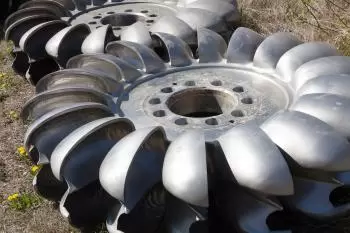
A water turbine is a machine that transforms the energy of a stream of water into mechanical energy using a system of rotating blades. This mechanical energy can be used to power another engine or an electrical generator.
Turbines are generally made up of a single rotor with blades, which provide energy exchange with the flow. The impeller blades deflect moving water to transform kinetic energy and pressure energy or exchange fluid momentum with a moment of force on the shaft.
The moment of forces in the shaft causes the rotation of the turbine generating rotational kinetic energy. Often, the turbine goes connected to an electric generator to get power generation. In other cases, this energy is used directly to obtain mechanical work using renewable energy.
Water turbines are the evolution of the antique water wheels.
Types of hydraulic turbines
Hydraulic turbines, used in hydropower installations, can be classified according to two criteria.
We can divide water turbines into two groups: reaction turbines and impulse turbines.
Reaction turbines are acted on by water as water moves through the turbine, change the pressure, and gives up its energy. Impulse turbines change the velocity of a water jet. The jet pushes on the turbine's curved blades, which changes the direction of the flow.
The resulting change in momentum (impulse) causes a force on the turbine blades. No pressure change occurs at the turbine blades.
Depending on its design, a turbine can be:
1. Pelton turbine
Pelton turbines are partial intake, cross-flow action turbines. One of the most efficient types of water turbines.
The Pelton wheel consists of a wheel (impeller or rotor) equipped with spoons on its periphery. These buckets are specially designed to convert the hydraulic energy of a jet of water that hits the buckets.
Pelton turbines are designed to exploit large, low-flow water head.
2. Francis turbine
The Francis turbine is an internal flow reaction turbine that combines both radial flow and axial flow concepts.
It consists of a fixed part, with curved guides called deflectors (or distributor), and a mobile element with blades, also curved, called a rotor. The deflectors’ inclination can adjust the blades’ flow, thus regulating the turbine’s speed.
It is a type of turbine very suitable for medium-high heads with medium flow rates, producing very high powers.
3. Kaplan turbine
Kaplan turbines are axial-flow reaction water turbines, with a roller similar to a ship's propeller.
They are used in installations with small waterfalls. A gate drives the wide blades of the turbine to release High-pressure water.
The water circulates in the same direction as the axis. In addition to regulating the deflectors’ inclination, it is also possible to hold the rotor blades’ tip.
It is used in installations with small waterfalls and large volumes of water, such as reservoirs.
4. Propeller turbine
Like all water turbines, the propeller turbine consists of a guide ring with guide blades and a rotor. Depending on the flow, the propeller turbine can be made with simple regulation (adjustment of guide blades) or double (adjustment of guide vanes and rotor rotation speed).
The guide vanes adjust the volume of water flow entering the rotor. At the same time, they change the flow direction to enter the rotor with its torque so that the rotor rotates.
A Mixed-Flow turbine is a type of turbine in which the flow of water through the runner is the first radial and then axial relative to the turbine axis.



